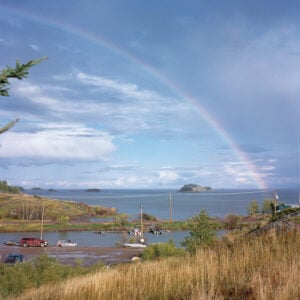
Environment
The truth about carbon capture
Carbon capture is big business, but its challenges fly in the face of the need to lower emissions. Can we square the circle on this technological Wild West?
- 5042 words
- 21 minutes
This article is over 5 years old and may contain outdated information.
History

Fort McMurray has earned itself a unique place in Canadian history books. Although originally established as a Hudson’s Bay Company trading post in 1870, these days, people know it as the home of Canada’s oil sands.
But what happened in between? In 1935, the Canadian Geographical Journal featured Fort McMurray in the magazine’s May issue (which only cost 25 cents at the time). [Read the full story and see early pictures of Fort McMurray here]
Despite the fact that Fort McMurray sits strategically at the junction of the Clearwater and Athabasca rivers, Lawrence J. Burpee wrote in the piece that the frontier town never seems to have been anything more than a “second-rate post,” adding that the town was interesting “not so much for what it was as for what it might have been.”
To illustrate his point, Burpee writes that although many historic expeditions and fur-trade brigades passed by its banks, very few stopped to camp in the place that was to become one of Canada’s most affluent residential areas. By the time Burpee visited the town it had an airport and was caught in an odd transition period where horsemen shared the dirt roads with cars and fur trappers chatted on telephones.
In a moment of prescience, Burpee hinted at Fort McMurray’s likely future in his piece:
“Neglected in the past, McMurray may yet win a measure of immortality. Passed by in the romantic story of exploration and the fur trade, it may achieve distinction in the more prosaic records of economic development. The high, wooded ridge behind the town is practically solid tar sand, and the Athabaska for a hundred miles is lined with banks of tar sand. Behind the ridge are salt wells the richness of which has already been proved. The north country is full of oil, and its mineral resources are only beginning to be understood…. One need not be much of a prophet to see the day when McMurray will be a large and flourishing city.”
That future would come. Despite a recent downturn in oil prices, the regional municipality of Wood Buffalo (technically Fort McMurray became an urban service area within the R.M. of Wood Buffalo, although most people still refer McMurray as a city) boasts Canada’s richest average household income ($191,507) and one of the country’s busiest airports.
Fort McMurray has come a long way since Burpee wrote about it. He finishes his story with a quote from a local resident, speaking about life in the odd little northern town:
“It can be cruel to weaklings or fools, but any man in reasonable health, with reasonable sense, should be happy and contented.”
Are you passionate about Canadian geography?
You can support Canadian Geographic in 3 ways:

Environment
Carbon capture is big business, but its challenges fly in the face of the need to lower emissions. Can we square the circle on this technological Wild West?

People & Culture
Author John Vaillant on his new book Fire Weather — and the toxic relationship between fire and petroleum

People & Culture
Through photographs and interviews, Canadian photographer Sara Hylton explores how human-caused impacts are damaging Fort Chipewyan, a small community in northern Alberta

People & Culture
The history behind the Dundas name change and how Canadians are reckoning with place name changes across the country — from streets to provinces